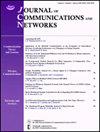An efficient application based many-to-many resource allocation and sharing with power optimization for D2D communication — A clustered approach
IF 3.2
3区 计算机科学
Q2 COMPUTER SCIENCE, INFORMATION SYSTEMS
引用次数: 0
Abstract
This study aims to give an edge to public safety applications over commercial applications in an underlay cellular-assisted device-to-device (D2D) communication. The proposed framework introduces two frameworks: Cluster-based many-to-many resource allocation and resource sharing framework (CMMRARS) and constant time power control algorithm (CTPCA). The RB assigned to a CUE can share with multiple DUE pairs, and the DUE pairs can also use RB assigned to multiple CUEs under the many-to-many strategy. The CMMRARS framework is responsible for resource allocation and resource sharing and accordingly, it is further divided into three sub-problems. The CTPCA framework is divided into two subproblems and used to find optimal power for cellular users and D2D transmitters to avoid cross-tier and co-tier interference. The K-means clustering algorithm is employed to form application-specific clusters, and it ensures that more cellular users fall into the public safety clusters so that the D2D users will get more resource-sharing options. Cellular users use a weighted bipartite graph to form a priority list of D2D users for resource sharing. The main objective of the proposed work is to enhance the system's sum rate by simultaneously reusing the same resource by multiple D2D pairs and safeguarding the Quality of Services provided to all kinds of network users. A theoretical justification is presented to ensure that the proposed frameworks terminate after a certain number of runs and congregate to a consistent matching. Simulation results show that the proposed method influences the overall system's sum rate and provides a preference for public safety applications over commercial applications.基于高效应用的多对多资源分配和共享以及 D2D 通信的功率优化 - 一种聚类方法
本研究旨在使公共安全应用在铺层蜂窝辅助设备对设备(D2D)通信中优于商业应用。拟议框架引入了两个框架:基于集群的多对多资源分配和资源共享框架(CMMRARS)和恒定时间功率控制算法(CTPCA)。在多对多策略下,分配给一个 CUE 的 RB 可以与多个 DUE 对共享,而 DUE 对也可以使用分配给多个 CUE 的 RB。CMMRARS 框架负责资源分配和资源共享,因此又分为三个子问题。CTPCA 框架分为两个子问题,用于寻找蜂窝用户和 D2D 发射器的最佳功率,以避免跨层和同层干扰。采用 K-means 聚类算法形成特定应用聚类,确保更多蜂窝用户属于公共安全聚类,以便 D2D 用户获得更多资源共享选择。蜂窝用户使用加权双向图形成 D2D 用户资源共享优先级列表。建议工作的主要目标是通过多个 D2D 对同时重复使用同一资源来提高系统的总和率,并保障向各类网络用户提供的服务质量。本文提出了理论依据,以确保提议的框架在运行一定次数后终止,并聚集到一致的匹配中。仿真结果表明,建议的方法影响了整个系统的总和率,并使公共安全应用优于商业应用。
本文章由计算机程序翻译,如有差异,请以英文原文为准。
求助全文
约1分钟内获得全文
求助全文
来源期刊
CiteScore
6.60
自引率
5.60%
发文量
66
审稿时长
14.4 months
期刊介绍:
The JOURNAL OF COMMUNICATIONS AND NETWORKS is published six times per year, and is committed to publishing high-quality papers that advance the state-of-the-art and practical applications of communications and information networks. Theoretical research contributions presenting new techniques, concepts, or analyses, applied contributions reporting on experiences and experiments, and tutorial expositions of permanent reference value are welcome. The subjects covered by this journal include all topics in communication theory and techniques, communication systems, and information networks. COMMUNICATION THEORY AND SYSTEMS WIRELESS COMMUNICATIONS NETWORKS AND SERVICES.

 求助内容:
求助内容: 应助结果提醒方式:
应助结果提醒方式:


